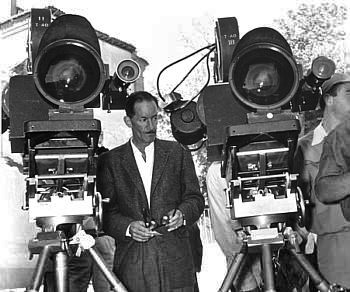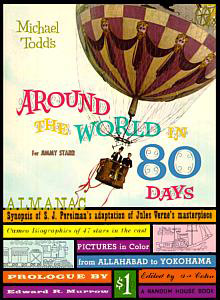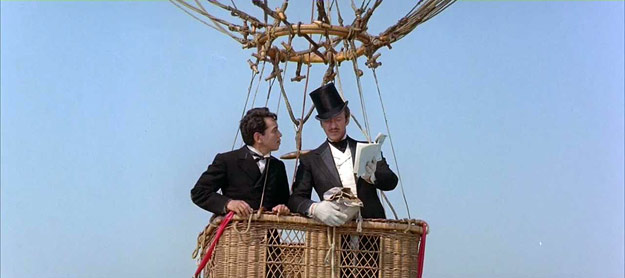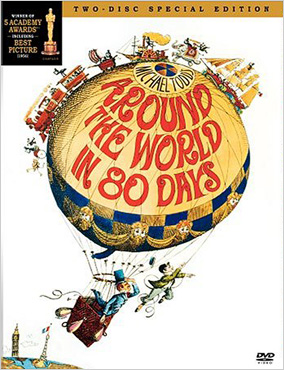Coate: Todd’s Around the World in Eighty Days was shot twice. Why?
Hall: The film was shot twice to allow a print-down 35mm version to be shown at the regular speed of 24 frames per second (fps) rather than the 30 fps of Todd-AO. But a 30-fps 35mm version was also made available in an anamorphic process Todd named Cinestage, so there was considerable room for flexibility!

Coate: Should both versions of the film be made available for the various ancillary markets?
Hall: Although it would be useful for scholars to have both versions available for comparison, the differences between them would most likely be too minimal to justify releasing both on a special edition Blu-ray.
Coate: Can you compare and contrast Todd’s Eighty Days with the original novel and numerous film and TV adaptations?
Hall: I’ve not read the novel and the only other adaptation I’ve seen (aside from the children’s animated series that used to appear on television in the 1970s) is the 2004 version starring Jackie Chan and Steve Coogan, which is simply dreadful.
Hart: Neither Mike Todd’s nor any other film or television producers have paid a lot of attention to the Verne novel. That doesn’t bother me in the least.
Holston: It remains the biggest and most star-studded cinematic version.
Coate: Where do you think Eighty Days ranks among producer Mike Todd’s body of work?
Hall: Todd’s body of work in the cinema is not very great. His involvement in Oklahoma! and before that Cinerama was somewhat peripheral, and I can’t comment on his non-film work. Eighty Days is really the only thing for which he’s remembered, aside from marrying Elizabeth Taylor and dying in a plane crash, neither of which was unique.
Hart: Since Mike Todd’s body of work includes just one film, which was an unbelievable money maker, and a bunch of Broadway musicals of varying quality it’s hard to say anything other than Eighty Days was at the top.
Holston: The apotheosis.
 Coate: Michael Todd’s involvement as producer seems to have overshadowed Michael Anderson’s contribution as director. What do you think Anderson brought to the project, and where do you think the film ranks among director Michael Anderson’s body of work?
Coate: Michael Todd’s involvement as producer seems to have overshadowed Michael Anderson’s contribution as director. What do you think Anderson brought to the project, and where do you think the film ranks among director Michael Anderson’s body of work?
Hall: Michael Anderson was an unusual choice of director because, at the age of 36 and with only a half-dozen, mostly low-budget feature films under his belt, he was relatively young and inexperienced for such a large-scale, expensive project as Eighty Days. Anderson had also only worked in Britain, not America; but it was perhaps this very freshness that appealed to Todd as a Hollywood outsider himself. Or perhaps it might have seemed to make the director more malleable and susceptible to the producer’s influence? In any event, Anderson had demonstrated his ability to handle complex logistics with his immediately preceding film The Dam Busters, a huge box-office hit in the UK, so perhaps that also gave him the commercial pedigree for the Todd job…. For me, The Dam Busters, Operation Crossbow and Eighty Days are (in that order) Anderson’s best film work, though I must admit to not having seen some of his early features (including a second 1956 release, the film adaptation of the TV play of George Orwell’s 1984, which sounds particularly intriguing).
Coate: What is the legacy of Around the World in Eighty Days?
Hall: It gave rise to two cycles of films in the late 1950s and 1960s: costume comedy-fantasies with a Victorian or Edwardian setting, often adapted from the work of Verne and other contemporary writers; and large-scale epic comedies involving a race or chase across continents. In artistic terms these films are not very significant, but some achieved considerable popularity if not much critical acclaim. The notion of all-star casts was also given a boost, appearing in a number of other films over the next few decades.
Hart: The legacy is muddled between Around the World in Eighty Days and Oklahoma!. The financial benefits found in the 70mm runs proved the roadshow concept. Only when Hollywood went ape-shit and started releasing horrible movies at high hard ticket prices thinking that they had created machines to print money did the attraction of the roadshow lose its mystique.
Holston: Merchandising and tie-ins: program, album, sheet music, game, ties, cuff links, bathrobes, carpetbags, costume jewelry. Todd is also credited with introducing “cameos,” the bit parts played by various internationally famous performers.
Coate: Thank you — Sheldon, Marty and Kim — for participating and sharing your thoughts about Around the World in Eighty Days on the occasion of its 60th anniversary.

SOURCES/REFERENCES
Primary references for this project included promotional material published in numerous daily newspapers archived digitally and/or on microfilm plus articles published in film industry trade publications Boxoffice, The Hollywood Reporter, and Variety, and the books Epics, Spectacles, and Blockbusters: A Hollywood History by Sheldon Hall and Steve Neale (Wayne State University Press, 2010), George Lucas’s Blockbusting: A Decade-by-Decade Survey of Timeless Movies Including Untold Secrets of Their Financial and Cultural Success edited by Alex Ben Block and Lucy Autrey Wilson (George Lucas Books/HarperCollins, 2010), and The Hollywood Reporter Book of Box Office Hits by Susan Sackett (Billboard, 1996). The websites in70mm.com and boxofficemojo.com were referenced for some information.
SELECTED IMAGES
Copyright/courtesy American Widescreen Museum, Michael Todd Company, United Artists, Warner Bros., Warner Home Video.
SPECIAL THANKS
Jim Barg, Rachel Bernstein, Raymond Caple, Sheldon Hall, Martin Hart, Mike Heenan, Kim Holston, Bill Kretzel, Mark Lensenmayer, NYer, Stephen Rice, Bob Throop, Vince Young, and to all of the librarians who helped with the research for this project, and to the Academy of Motion Picture Arts and Sciences’ Margaret Herrick Library and Fairbanks Center for Motion Picture Study.
All figures and data included in this article pertain to the United States and Canada except where stated otherwise.
- Michael Coate
Michael Coate can be reached via e-mail through this link.





